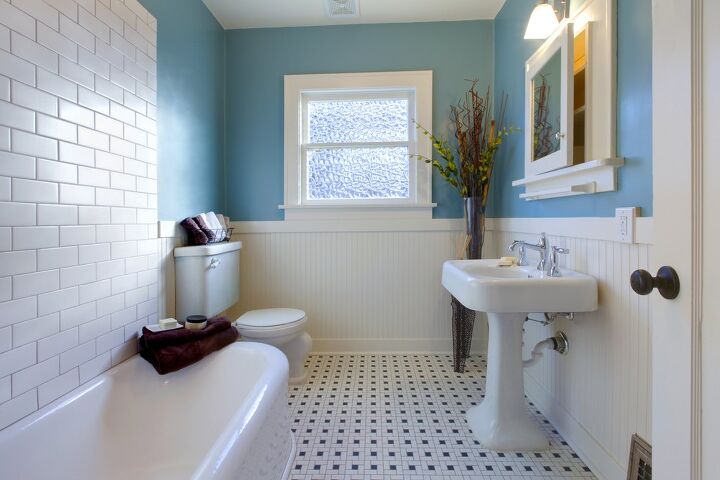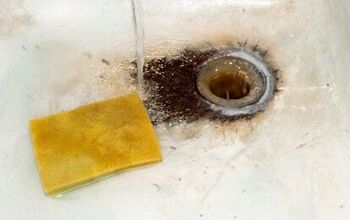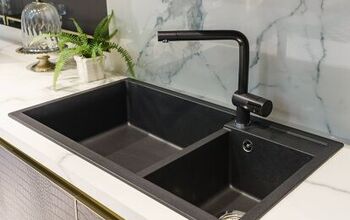What Are The Pros And Cons Of Cast Iron Sinks?

Cast Iron sinks were invented in the 1920’s and have stood the test of time as a kitchen icon. Both durable and versatile, cast iron sinks are created with two layers. The bottom layer is a heavy iron alloy, and the top is a colored enamel (usually white) that has a glossy finish. These vintage sinks have been modernized with trendy colors like navy and gray, and they look fantastic either inlaid or with a farmhouse design.
The pros of owning a cast iron sink are durability, stain resistance, and beautiful design. The cons of cast iron sinks are heavy weight, a higher price, and the risk of rusting from chipped enamel. Cast iron sinks may be customizable when purchased, but changing its features is more difficult once installation is complete.
With ultra-durability and customizable colors, these sinks are both practical and aesthetically pleasing. But they do have their drawbacks. In this article, we will explore the advantages and disadvantages of bringing cast iron into your home.
Do You Need a Faucet, Fixture, or Pipe Repair or Replacement?
Get free, zero-commitment quotes from pro contractors near you.

Pros Of Cast Iron Sinks
These are ideal for everyday use and can serve your kitchen well for many years. Let’s take a look at the many benefits they have to offer, and their potential drawbacks.
Extremely Durable
Few would argue with the integrity of cast iron. These sinks seem to last forever, and rarely need to be replaced when properly cared for.
While it’s possible for the enamel to chip or scratch, the sink itself can last many decades. The porcelain enamel will also last for decades when well taken care of.
Avoid abrasive cleaners and steel wool to prevent scratches, and be mindful of sharp knives and other utensils in the sink for the same reason. If your enamel does scratch or chip, it can be refinished.
Resistant to Staining
Cast iron sinks are overlaid with porcelain enamel and are great at staying their original color. While you wouldn’t want to leave marinara sauce sitting in a white cast iron sink overnight, these are generally stain-resistant.
Compared to an acrylic sink, these do a fantastic job of washing unwanted pigment down the drain. Lighter colored acrylic has the unwanted characteristic of staining more easily. Cast iron allows for color customization without the anxiety of possible staining.
Beautifully Designed
A main reason cast iron is chosen is for its classic, iconic appeal. They are a great complement to country chic and farmhouse-style homes.
These sinks are also versatile and can easily fit in with most decor. There are a variety of colors to choose from, so these can blend in with a calm, relaxed kitchen or can brightly accent your room with a well-chosen pop of color.
Cons of Cast Iron Sinks
Heavy Weight
The weight of cast iron is definitely a factor to consider. While its weight contributes to its durability, this also makes it difficult to manage and install.
Manufacturing and processing heavy items adds to the cost, and transporting it from the store to your home may not be an easy task either. Make sure you bring help with you for both the pickup and installation, if you choose to install it yourself.
Because of its weight, this type of sink must also be supported extremely well from underneath. Even drop-in cast iron sinks can use a wooden frame for support (using metal support is even better).
Greater Expense
Cast iron costs more than your average sink. Part of this extra expense comes from the materials used and the extra care and manpower needed to handle such a heavy item.
If you’re interested in a cast iron sink, but don’t have quite enough in your budget for it, there are some ways to mitigate the cost. Apart from your local home improvement stores, there are many places to find a more affordable option.
Consider A “Vintage” Sink
Many people need to offload their sinks during a remodel, and want to sell them quickly on a public forum like Craigslist. Sometimes, sinks are leftover from a demolition of older homes which could work beautifully in a modern home.
These options can be especially useful if you’re handy and could do some light refurbishing yourself.
When shopping for a used sink, it can take a few days or weeks for a suitable option to appear, but your patience could really pay off. Here are some great places to find older sinks at a fraction of the price:
- Scrapyards
- Craigslist
- Facebook Marketplace
- Larger thrift stores
- Vintage and Antique markets
- Local yard sales
Enamel Chipping
Another important consideration is the risk of chipped enamel with use. Cast iron is heavy-duty and reliable, but its porcelain enamel coating has the drawback of potential scuffing, scratching, and chipping.
Beyond being a potential eyesore, this also exposes the iron underneath, which can lead to rust. This can compromise the sink’s integrity if left unchecked and can be undesirable in a place where people prepare and eat food.
Small amounts of rust coming in contact with dirty dishes, or even landing in food, isn’t a reported health hazard in most cases. But it’s definitely unwanted as it can cause stains, and certainly doesn’t add the best flavor!
Avoiding deep scratches and repairing sinks with rust is absolutely necessary to properly care for your sink, and this will require careful attention and possible extra cost later on.
Positives And Negatives Of Customization
Style and color are the two strong points of a cast iron sink’s customization choices.
They are generally available in three styles:
- Drop-in
- Undermount
- Apron front
This versatility in style allows for the sink to fit your space well both functionally and artistically.
Adding A Bit Of Color
Branching out with color in your kitchen works well with a cast iron sink. Multiple colors are available well beyond what you may find with other sink options.
Acrylic sinks also provide wide color choices, and are more affordable. But these tend to be far less durable and can also stain very easily. Cast iron provides a higher-quality option for customized color.
Customization Problems
The main problem you may come across with customization happens after installation. If you’d like to change anything about the sink after it’s installed, it could prove very difficult.
Any changes to the sink becomes more challenging at this point because of its weight and the toughness of the materials.
Drilling holes for new faucets and features could be more intensive and require special tools beyond what you would use on other sinks, like stainless steel. You may also need to repair damage to the enamel to prevent rust.
Should You Install A Cast Iron Sink Yourself?
Because of its weight and need for extra support, professionals are often called in to take care of installation. But if you want to try your hand at this yourself, here are some guidelines for installing an undermount cast iron sink.
Step 1: Have your countertop ready for the install. It should be cut to the correct dimensions to cover your sink.
Step 2: Assemble an appropriate undermount kit. This will be included with a new sink purchase, or can be bought at a local home improvement store. It will typically consist of hanger brackets, rails, nuts, and bolts, and is relatively simple to put together.
Step 3: Measure and secure the undermount. Rails should be placed according to where your sink will be placed using hanger brackets. Make sure the sink will rest securely on the rails by carefully measuring your sink’s width.
Step 4: Place sink onto rails. These sinks can weigh up to 300 pounds, so make sure you have physical help for this part. Don’t try this step alone!
Step 5: Check that the sink is level. Make sure the sink fits securely on the rails, and isn’t tilted. You may need to remove the sink and adjust the rails’ positioning, but it’s worth the extra effort to get it right.
Step 6: Install counter. Place the countertop carefully onto the sink.
Step 7: Apply silicone sealant. Use a thin line of sealant where the sink meets the countertop. Let this cure for about half an hour before proceeding.
Step 8: Finish the plumbing connections. Install tap and drain connections underneath, and run water to check for any leaks.
Pay special attention to the mounting underneath for this type of installation. This will be the primary support holding this heavy sink up in the right position.
Even if you decide to install a drop-in style sink, which relies on support from the counter, you’ll still want to create a wooden frame beneath. This way, if your countertop’s integrity is compromised for any reason, your heavy sink won’t collapse to the floor.
Do You Need a Faucet, Fixture, or Pipe Repair or Replacement?
Get free, zero-commitment quotes from pro contractors near you.

Our Take On Cast Iron Sinks
These sinks definitely have their pros and cons. You may be on a tighter budget than cast iron allows, and don’t want to procure a used one. In this case, you may want to go with a less expensive option and a more manageable installation.
But if you don’t mind spending a bit more than you would for the average sink, cast iron is a great choice for a new kitchen or remodel. The benefits of durability coupled with its vintage beauty will serve you well for many years to come.

Paige is an elementary school librarian with a passion for writing. Her hobbies include reading an exorbitant amount of fantasy, slowly teaching herself to draw, and home decor. While she isn't the most talented artist or interior designer, what she lacks in skill she more than makes up for in enthusiasm. When she's not curled up with a book, you can certainly find her curled over the keyboard.
More by Paige Hanawalt



















![How To Reset A Whirlpool Cabrio Washer [In 5 Easy Steps!]](https://cdn-fastly.upgradedhome.com/media/2023/07/31/9076531/how-to-reset-a-whirlpool-cabrio-washer-in-5-easy-steps.jpg?size=350x220)







